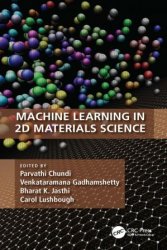Machine Learning in 2D Materials Science
- Добавил: literator
- Дата: 6-12-2023, 07:32
- Комментариев: 0
 Название: Machine Learning in 2D Materials Science
Название: Machine Learning in 2D Materials ScienceАвтор: Parvathi Chundi, Venkataramana Gadhamshetty, Bharat K. Jasthi, Carol Lushbough
Издательство: CRC Press
Год: 2024
Страниц: 249
Язык: английский
Формат: pdf (true)
Размер: 27.7 MB
Data Science and Machine Learning (ML) methods are increasingly being used to transform the way research is being conducted in materials science to enable new discoveries and design new materials. For any materials science researcher or student, it may be daunting to figure out if ML techniques are useful for them or, if so, which ones are applicable in their individual contexts, and how to study the effectiveness of these methods systematically.
Machine Learning (ML) has evolved as a subfield of Artificial Intelligence (AI), learning from the data collected historically or from experiments, and using it for future actions. In general, ML models consider the patterns of the input and adjusts internal structures to approximate the relationship between input and output. ML is also used to identify hidden patterns of data distributions to come up with meaningful relationships. The ability to learn unforeseen relationships from data without depending on explicitly programmed prior guidance is one of the main reasons why there are a plethora of ML-based applications. The very early definition for ML, “Field of study that gives computers the ability to learn without being explicitly programmed” is still valid.
Key features:
Provides broad coverage of data science and ML fundamentals to materials science researchers so that they can confidently leverage these techniques in their research projects
Offers introductory material in topics such as ML, data integration, and 2D materials
Provides in-depth coverage of current ML methods for validating 2D materials using both experimental and simulation data, researching and discovering new 2D materials, and enhancing ML methods with physical properties of materials
Discusses customized ML methods for 2D materials data and applications and high-throughput data acquisition
Describes several case studies illustrating how ML approaches are currently leading innovations in the discovery, development, manufacturing, and deployment of 2D materials needed for strengthening industrial products
Gives future trends in ML for 2D materials, explainable AI, and dealing with extremely large and small, diverse datasets
Aimed at materials science researchers, this book allows readers to quickly, yet thoroughly, learn the ML and AI concepts needed to ascertain the applicability of ML methods in their research.
Скачать Machine Learning in 2D Materials Science
Внимание
Уважаемый посетитель, Вы зашли на сайт как незарегистрированный пользователь.
Мы рекомендуем Вам зарегистрироваться либо войти на сайт под своим именем.
Уважаемый посетитель, Вы зашли на сайт как незарегистрированный пользователь.
Мы рекомендуем Вам зарегистрироваться либо войти на сайт под своим именем.
Информация
Посетители, находящиеся в группе Гости, не могут оставлять комментарии к данной публикации.
Посетители, находящиеся в группе Гости, не могут оставлять комментарии к данной публикации.
